An unsettling seasonal tale of ghosts
Folklore, religions, and mythologies speak of many kinds of ghosts. Usually, at this time of year, in the run up to Christmas, I can be found blogging about the three ghosts of Christmas past, present and future in Charles Dickens’ Christmas morality tale “A Christmas Carol”. This year, with assignment deadlines sometimes looming on the far side of the holidays, I wanted to warn you of the dangers of another kind of ghost – the ghost writer.







